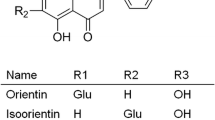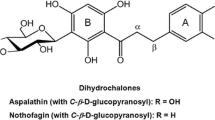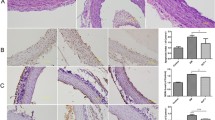Abstract
Aim and objective
Fisetin, an active compound isolated from flowering plants in the family Fabaceae, was reported to have antiviral, neuroprotective, and anti-inflammatory effects. Vascular inflammatory processes have been suggested to play key roles in the initiation and progression of atherosclerosis, a major complication of diabetes mellitus. Thus, we determined the ability of fisetin to suppress vascular inflammatory processes induced by high glucose (HG) in primary human umbilical vein endothelial cells (HUVECs) and mice.
Methods
The effects of fisetin on HG-induced vascular inflammation were determined by measuring vascular permeability, leukocyte adhesion and migration, cell adhesion molecule (CAM) expression levels, reactive oxygen species (ROS) formation, and nuclear factor (NF)-κB activation.
Results
HG markedly increased vascular permeability, monocyte adhesion, expressions of CAMs, formation of ROS, and activation of NF-κB. Remarkably, all of the observed vascular inflammatory effects induced by HG were inhibited by pretreatment with fisetin.
Conclusion
Vascular inflammatory responses induced by HG are critical events underlying the development of diabetic complications; therefore, our results suggest that fisetin possesses significant therapeutic effects against diabetic complications and atherosclerosis.






Similar content being viewed by others
References
Whiting DR, Guariguata L, Weil C, Shaw J. IDF diabetes atlas: global estimates of the prevalence of diabetes for 2011 and 2030. Diabetes Res Clin Pract. 2011;94:311–21.
Thomas JE, Foody JM. The pathophysiology of cardiovascular disease in diabetes mellitus and the future of therapy. J Cardiometab Syndr. 2007;2:108–13.
Roglic G, Unwin N, Bennett PH, Mathers C, Tuomilehto J, Nag S, et al. The burden of mortality attributable to diabetes: realistic estimates for the year 2000. Diabetes Care. 2005;28:2130–5.
Holman R, Turner R (1991) Textbook of diabetes. Oxford: Blackwell.
Li GQ, Kam A, Wong KH, Zhou X, Omar EA, Alqahtani A, et al. Herbal medicines for the management of diabetes. Adv Exp Med Biol. 2012;771:396–413.
Day C. Traditional plant treatments for diabetes mellitus: pharmaceutical foods. Br J Nutr. 1998;80:5–6.
Gerrity RG. The role of the monocyte in atherogenesis: I. transition of blood-borne monocytes into foam cells in fatty lesions. Am J Pathol. 1981;103:181–90.
Wardle EN. Vascular permeability in diabetics and implications for therapy. Diabetes Res Clin Pract. 1994;23:135–9.
Esposito C, Fasoli G, Plati AR, Bellotti N, Conte MM, Cornacchia F, et al. Long-term exposure to high glucose up-regulates VCAM-induced endothelial cell adhesiveness to PBMC. Kidney Int. 2001;59:1842–9.
Hamuro M, Polan J, Natarajan M, Mohan S. High glucose induced nuclear factor kappa B mediated inhibition of endothelial cell migration. Atherosclerosis. 2002;162:277–87.
Morigi M, Angioletti S, Imberti B, Donadelli R, Micheletti G, Figliuzzi M, et al. Leukocyte-endothelial interaction is augmented by high glucose concentrations and hyperglycemia in a NF-kB-dependent fashion. J Clin Invest. 1998;101:1905–15.
Tooke JE. Microvascular function in human diabetes a physiological perspective. Diabetes. 1995;44:721–6.
Nannipieri M, Rizzo L, Rapuano A, Pilo A, Penno G, Navalesi R. Increased transcapillary escape rate of albumin in microalbuminuric type II diabetic patients. Diabetes Care. 1995;18:1–9.
Aggarwal BB, Ichikawa H, Garodia P, Weerasinghe P, Sethi G, Bhatt ID, et al. From traditional ayurvedic medicine to modern medicine: identification of therapeutic targets for suppression of inflammation and cancer. Expert Opin.Therapeutic Targets. 2006;10:87–118.
Bae JS. Role of high mobility group box 1 in inflammatory disease: focus on sepsis. Arch Pharm Res. 2012;35:1511–23.
Middleton E Jr, Drzewiecki G. Flavonoid inhibition of human basophil histamine release stimulated by various agents. Biochem Pharmacol. 1984;33:3333–8.
Mukaida N. Interleukin-8: an expanding universe beyond neutrophil chemotaxis and activation. Int J Hematol. 2000;72:391–8.
Hirano T, Higa S, Arimitsu J, Naka T, Ogata A, Shima Y, et al. Luteolin, a flavonoid, inhibits AP-1 activation by basophils. Biochem Biophys Res Commun. 2006;340:1–7.
Bakay M, Mucsi I, Beladi I, Gabor M. Effect of flavonoids and related substances. II. Antiviral effect of quercetin, dihydroquercetin and dihydrofisetin. Acta Microbiol Acad Sci Hung. 1968;15:223–7.
Sung B, Pandey MK, Aggarwal BB. Fisetin, an inhibitor of cyclin-dependent kinase 6, down-regulates nuclear factor-kappaB-regulated cell proliferation, antiapoptotic and metastatic gene products through the suppression of TAK-1 and receptor-interacting protein-regulated IkappaBalpha kinase activation. Mol Pharmacol. 2007;71:1703–14.
Akaishi T, Morimoto T, Shibao M, Watanabe S, Sakai-Kato K, Utsunomiya-Tate N, et al. Structural requirements for the flavonoid fisetin in inhibiting fibril formation of amyloid beta protein. Neurosci Lett. 2008;444:280–5.
Lee W, Ku SK, Bae JS. Emodin-6-O-beta-d-glucoside down-regulates endothelial protein C receptor shedding. Arch Pharm Res. 2013;36:1160–5.
Bae JS, Rezaie AR. Thrombin inhibits HMGB1-mediated proinflammatory signaling responses when endothelial protein C receptor is occupied by its natural ligand. BMB Rep. 2013;46:544–9.
Bae JS, Lee W, Rezaie AR. Polyphosphate elicits proinflammatory responses that are counteracted by activated protein C in both cellular and animal models. J Thromb Haemost. 2012;10(6):1145–51.
Lee JD, Huh JE, Jeon G, Yang HR, Woo HS, Choi DY, et al. Flavonol-rich RVHxR from Rhus verniciflua Stokes and its major compound fisetin inhibits inflammation-related cytokines and angiogenic factor in rheumatoid arthritic fibroblast-like synovial cells and in vivo models. Int Immunopharmacol. 2009;9:268–76.
Akeson AL, Woods CW. A fluorometric assay for the quantitation of cell adherence to endothelial cells. J Immunol Methods. 1993;163:181–5.
Kim I, Moon SO, Kim SH, Kim HJ, Koh YS, Koh GY. Vascular endothelial growth factor expression of intercellular adhesion molecule 1 (ICAM-1), vascular cell adhesion molecule 1 (VCAM-1), and E-selectin through nuclear factor-kappa B activation in endothelial cells. J Biol Chem. 2001;276:7614–20.
Mackman N, Brand K, Edgington TS. Lipopolysaccharide-mediated transcriptional activation of the human tissue factor gene in THP-1 monocytic cells requires both activator protein 1 and nuclear factor kappa B binding sites. J Exp Med. 1991;174:1517–26.
Laakso M. Hyperglycemia and cardiovascular disease in type 2 diabetes. Diabetes. 1999;48:937–42.
Kannel WB, McGee DL. Diabetes and cardiovascular disease. The Framingham study. JAMA. 1979;241:2035–8.
Sander B, Larsen M, Engler C, Lund-Andersen H, Parving HH. Early changes in diabetic retinopathy: capillary loss and blood-retina barrier permeability in relation to metabolic control. Acta Ophthalmol (Copenh). 1994;72:553–9.
Lopes-Virella MF, Virella G. Immune mechanisms of atherosclerosis in diabetes mellitus. Diabetes. 1992;41(Suppl 2):86–91.
Kado S, Wakatsuki T, Yamamoto M, Nagata N. Expression of intercellular adhesion molecule-1 induced by high glucose concentrations in human aortic endothelial cells. Life Sci. 2001;68:727–37.
Hansson GK, Libby P. The immune response in atherosclerosis: a double-edged sword. Nat Rev Immunol. 2006;6:508–19.
Boisvert WA. Modulation of atherogenesis by chemokines. Trends Cardiovasc Med. 2004;14:161–5.
Inoguchi T, Li P, Umeda F, Yu HY, Kakimoto M, Imamura M, et al. High glucose level and free fatty acid stimulate reactive oxygen species production through protein kinase C-dependent activation of NAD(P)H oxidase in cultured vascular cells. Diabetes. 2000;49:1939–45.
Dunlop M. Aldose reductase and the role of the polyol pathway in diabetic nephropathy. Kidney Int Suppl. 2000;77:S3–12.
Han HJ, Lee YJ, Park SH, Lee JH, Taub M. High glucose-induced oxidative stress inhibits Na+/glucose cotransporter activity in renal proximal tubule cells. Am J Physiol Renal Physiol. 2005;288:F988–96.
Rimbach G, Valacchi G, Canali R, Virgili F. Macrophages stimulated with IFN-gamma activate NF-kappa B and induce MCP-1 gene expression in primary human endothelial cells. Mol Cell Biol Res Commun. 2000;3:238–42.
Uemura S, Matsushita H, Li W, Glassford AJ, Asagami T, Lee KH, et al. Diabetes mellitus enhances vascular matrix metalloproteinase activity: role of oxidative stress. Circ Res. 2001;88:1291–8.
Acknowledgments
This study was supported by the National Research Foundation of Korea (NRF) funded by the Korea government [MSIP] (Grant Nos. 2013-067,053 and NRF-2012R1A4A1028835).
Conflict of interest
The authors declare no conflicts of interest.
Author information
Authors and Affiliations
Corresponding author
Additional information
Responsible Editor: Liwu Li.
S. Kwak and S.-K. Ku contributed equally to this work.
Rights and permissions
About this article
Cite this article
Kwak, S., Ku, SK. & Bae, JS. Fisetin inhibits high-glucose-induced vascular inflammation in vitro and in vivo. Inflamm. Res. 63, 779–787 (2014). https://doi.org/10.1007/s00011-014-0750-4
Received:
Revised:
Accepted:
Published:
Issue Date:
DOI: https://doi.org/10.1007/s00011-014-0750-4




